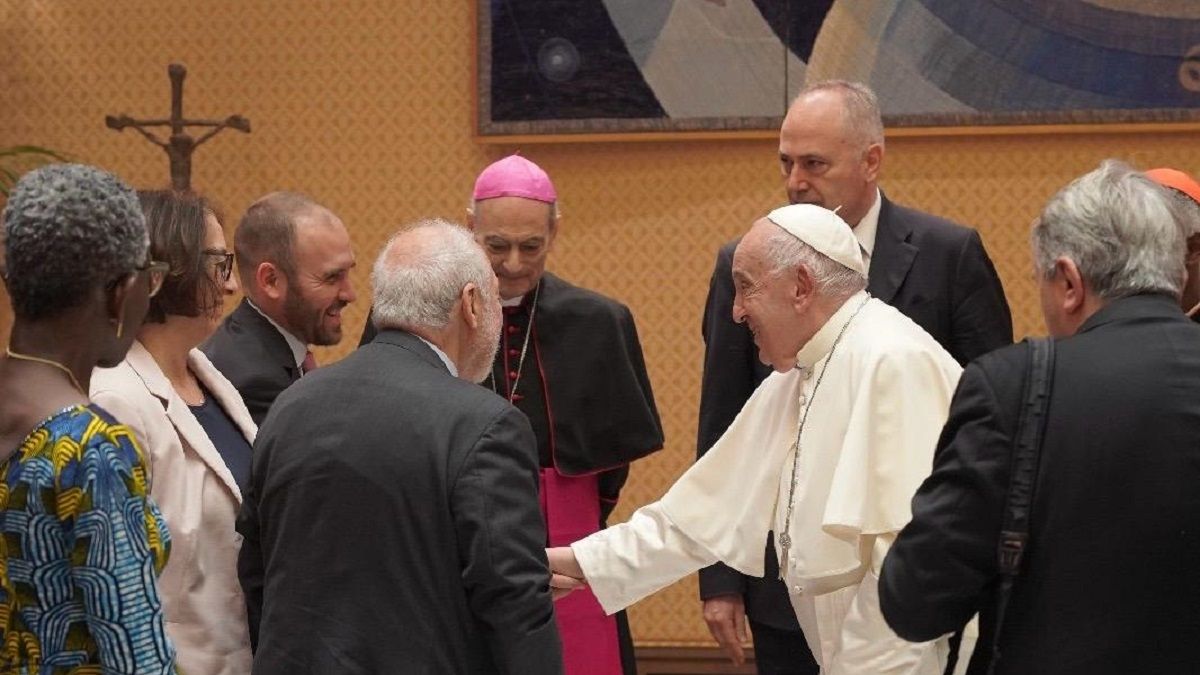The indebtedness crisis In dependent, poor and some emerging countries, he deepened in the last decade. More than 3.3 billion people live in countries that spend more on debt services than health and There are 54 countries that allocate more than 10% of their fiscal income to interest payment. An infor in charge by Pope Francis and presented this Friday at the Vatican alert about this situation and promotes urgent measures and structural changes In international finance: from liabilities to a reform of the legislation of key districts, such as New York or England.
Within the framework of their proclamation in favor of a worldwide debt relief, Francisco entrusted them months ago to prepare a document for the current year of the Jubilee to the US economist Joseph Stiglitzwinner of the Nobel Prize, already Martín Guzmánformer Minister of Economy of Argentina, who formed a commission with more than 30 experts from different countries. According to the sources of the commission, the calls that nourish the report now have the support of the Pope Leo XIV.
The antecedent of this initiative is rolling a year 2000the previous jubilee. At that time the Foronation of more than US $ 100,000 million In international liabilities, within the framework of a plan for the relief of the debt of highly indebted poor countries (PPME, better known as Hipc for its acronym in English). But The lack of structural changes that prevent the financial asphyxiation of vulnerable nations by global power centers, combined with shocks such as Coronavirus pandemic, returned to these and other countries to a critical situation.
The debt and development crisis
The report, to which he had access Scopeemphasizes that “the fiscal figures of the developing world have a Fruiting panorama” Since 2014, the average interest load for developing countries, measured as a percentage of tax revenues, almost doubled. The situation is such that there are 54 countries that, at present, spend 10% or more of their income on the payment of those interest, says the document based on information from the United Nations Conference on Commerce and Development.
“Nowadays, 3.3 billion people live in countries that spend more on interest than healthand 2.1 billion live in countries that spend more on interest than in education. Therefore, public debt interest payments are displacing crucial investments in health, education, infrastructure and climatic resilience. Governments, fearful of political and economic costs to initiate debt restructuring, prioritize the specific payment of debt on essential development. This is not a path to sustainable development. Rather, it constitutes an obstacle to development and leads to growing inequality and discontent, ”warns the report.
It is that, far from financing investment for development, external indebtedness reinforces the dependence of the interests of the great global economic powers and transnational financial capital. “There is a growing consensus among experts: The current debt system is at the service of financial markets, not people. This threatens to condemn entire nations to a lost decade – or something worse. The time has come to act responsibly, ”said Stiglitz, who presided over the commission responsible for preparing the document.
Urgent measures and structural reforms
Supported by the background of 25 years ago, the document indicates that An “Hipc II” initiative could help advance restructuring with removes of nominal value of the most pressing debts, which go beyond A suspension of payments For a set of countries in critical situation, such as the one agreed during the pandemic.
“The international community has the moral obligation to boost a hipc II. However, the challenges to implement such an integral solution today are greater than those that faced during the original hipc initiative. The changing panorama of the creditors implies that a new initiative would have to go beyond the political agreements between the creditors and involve the private creditorswho now play a much greater role in the debt portfolios of low-income and average income countries than in the 1990s, ”says the report.
To do this, the Commission raises the need to modify incentives. In what would imply a challenging turn of current policies, The document urges the International Monetary Fund (IMF) and multilateral banks to abandon the rescue policies “de facto” Private creditors Before the balance of payments of the relatives no longer impose “suffocating austerity policies”. Two principles that, in fact, mark the “modus operandi” of institutions such as the IMF, which reflect the guidelines of its main shareholders (USA and other great powers).
Another of the challenging structural changes promoted by the document backed by the Vatican is an “urgent” reform of the legislation of districts such as the state of New York and England, where Issues most bonds Sovereigns of developing countries precisely for their legal frameworks widely favorable to financial capitals. Some of the proposed modifications tune in with an existing bill in the New York Parliament, whose approval chances still look distant.
Specifically, the report raises three imperatives in this regard: Limit “the capacity of vulture funds to recover extraordinary profits from debt in difficulties, especially in cases where restructuring of good faith is being carried out ”; Reduce the interest rate prior to the trial that has governed since 1981 in New York and that is set at 9% per year since “mainly benefits the litigating creditors and inflates the value of their claims the longer an unsolved case remains”; and Apply “recovery stops” for private creditors depending on the restructuring conditions accepted by the official creditors of the countries in question.
Among other measures suggested by the Commission chaired by Stiglitz, it is also recommended to strengthen the internal policies of developing countries or with large debt loads regarding Controls on the Movement of Capital Golondrina to reduce exposure to destabilizing flows and promote long -term investments.
The idea contrasts with the recent flexibility of restrictions for foreign capitals implemented by the government of Javier Milei: In search of stimulating the debt placements of the Argentine Treasury, the BCRA eliminated (for a good part of the funds that enter) the mandatory minimum permanence of six months in the country. In fact, the minister Luis Caputo bets on debt as almost exclusive via to recompose reservationsin a country like Argentina that in the coming years will face a mountain of maturities in foreign currency (a good part of which originated during their management in the government of Mauricio Macri).
After its presentation in the Vatican, the results of the Stiglitz, Guzmán and other members of the Commission will bring the debates to the 4th International Conference on Development Financingwhich will be held in Seville, Spain, from June 30 to July 3, to the General Assembly of the UN In September (in New York, USA) and the Summit of the G20 In November (in Johannesburg, South Africa).
“In this jubilee year, a determined coalition must act to resolve debt and development crises, or otherwise, the inequality of opportunities will increase and instability will be aggravated, with destabilizing consequences in the medium term worldwide,” Guzmán said.
Source: Ambito




